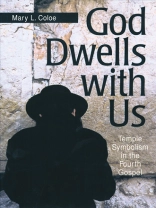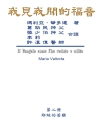The image of the Temple speaks of a building, of a place of God’s heavenly presence, and yet the experience of many Christians has been of God’s indwelling in the human heart. In God Dwells with Us, Mary Coloe crosses the centuries through John’s Gospel text and plunges into the experience of the Johannine community. Here, readers receive a sense of God’s indwelling as promised by Jesus, and how it relates to the symbol of the Temple in the gospel narrative.
In the years after the destruction of Jerusalem and its Temple, the Johannine community looked to the symbol of the Temple as a key means of expressing its new faith in Jesus. During his lifetime he was the living presence of Israel’s God dwelling in history. In the absence of the historical Jesus, the believing community – past, present, and future – continue to be a locus for the divine indwelling and so can truly be called a living Temple.
God Dwells with Us offers a new and consistent perspective on the symbol of the Temple which clarifies the christology of the Fourth Gospel. It establishes a new plot for this gospel – the destroying and raising of the Temple; and shows how this occurs within the text. The chapters provide a new approach to its structure. It is unique in its treatment of John14:2 where it establishes that the new Temple is the household of believers on earth. It also presents a new interpretation of the Johannine Crucifixion and the scene with Jesus’ mother and the Beloved Disciple.
Chapters are God’s Dwelling Place in Israel, ’ 'The Temple of His Body: 2:13-15, ’ 'The Supplanter: 4:1-45, ”The Tabernacling Presence of God: 7:1-8:59, ’ 'The Consecrated One: 10:22-42, ’ 'My Father’s House 14:1-31, ’ and 'Raising the New Temple: 18:1-19:42.’
Mary L. Coloe, PBVM, Th D, teaches at the Australian Catholic University at Melbourne.
’O autorze
Mary L. Coloe, PBVM, is professor of New Testament at Yarra Theological Union, a college of the University of Divinity in Melbourne. Mary taught for over twenty years at Australian Catholic University and also at Boston College, the Jesuit School of Theology in Berkeley, and in Jerusalem. Mary has many academic publications on the Gospel of John, as well as books to help parents and teachers, such as A Friendly Guide to John, The Two Hands of God, and A Friendly Guide to the Birth of Jesus. Mary has also written an introduction to the Johannine literature for the new revised edition of the Jerome Biblical Commentary.












